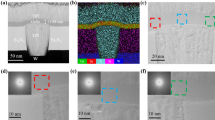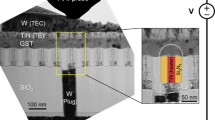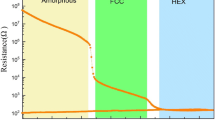Abstract
Further improvement of storage density is a key challenge for the application of phase-change memory (PCM) in storage-class memory. However, for PCM, storage density improvements include feature size scaling down and multi-level cell (MLC) operation, potentially causing thermal crosstalk issues and phase separation issues, respectively. To address these challenges, we propose a high-aspect-ratio (25:1) lateral nanowire (NW) PCM device with conventional chalcogenide Ge2Sb2Te5 (GST-225) to realize stable MLC operations, i.e., low intra- and inter-cell variability and low resistance drift (coefficient = 0.009). The improved MLC performance is attributed to the high aspect ratio, which enables precise control of the amorphous region because of sidewall confinement, as confirmed by transmission electron microscopy analysis. In summary, the NW devices provide guidance for the design of future high-aspect-ratio three-dimensional PCM devices with MLC capability.
摘要
如何进一步提高存储密度是相变存储(PCM)应用于存储级内存 (SCM)的关键挑战. 然而, 相变存储器主要通过尺寸微缩和多值操作来 提高存储密度, 往往面临严重的热串扰和相分离问题. 为此, 我们提出 了一种高长宽比(25:1)的横向纳米线器件, 该器件采用传统的硫系化合 物Ge2Sb2Te5 就可以实现稳定的多值操作, 并且器件具有较好的一致性 以及较低的电阻漂移系数(0.009), 其优异的多值性能主要是由于在设 计的高长宽比结构中, 绝缘层侧壁的限制使得相变材料的非晶区域可 以精确控制, 这也被透射电子显微镜分析证实. 本文设计的纳米线器件 为提升高深宽比三维相变存储器的多值存储能力提供了重要指导.
Similar content being viewed by others
References
Daly DC, Fujino LC, Smith KC. Through the looking glass—the 2017 edition: Trends in solid-state circuits from ISSCC. IEEE Solid-State Circuits Mag, 2017, 9: 12–22
Lam CH. Storage class memory. In: IEEE International Conference on Solid-State and Integrated Circuit Technology. Shanghai, 2010. 978
Lee S, Jeong J, Lee TS, et al. Bias polarity dependence of a phase change memory with a Ge-doped SbTe: A method for multilevel programing. Appl Phys Lett, 2008, 92: 243507
Kim T, Lee S. Evolution of phase-change memory for the storage-class memory and beyond. IEEE Trans Electron Devices, 2020, 67: 1394–1406
Lee SH, Jung Y, Agarwal R. Highly scalable non-volatile and ultra-low-power phase-change nanowire memory. Nat Nanotech, 2007, 2: 626–630
Raoux S, Burr GW, Breitwisch MJ, et al. Phase-change random access memory: A scalable technology. IBM J Res Dev, 2008, 52: 465–479
Simpson RE, Krbal M, Fons P, et al. Toward the ultimate limit of phase change in Ge2Sb2Te5. Nano Lett, 2010, 10: 414–419
Rao F, Ding K, Zhou Y, et al. Reducing the stochasticity of crystal nucleation to enable subnanosecond memory writing. Science, 2017, 358: 1423–1427
Loke D, Lee TH, Wang WJ, et al. Breaking the speed limits of phase-change memory. Science, 2012, 336: 1566–1569
Li XB, Chen NK, Wang XP, et al. Phase-change superlattice materials toward low power consumption and high density data storage: Microscopic picture, working principles, and optimization. Adv Funct Mater, 2018, 28: 1803380
Giannopoulos I, Sebastian A, Gallo ML, et al. 8-bit precision inmemory multiplication with projected phase-change memory. In: IEEE International Electron Devices Meeting (IEDM). San Francisco, 2018. 628–631
Zhang W, Mazzarello R, Wuttig M, et al. Designing crystallization in phase-change materials for universal memory and neuro-inspired computing. Nat Rev Mater, 2019, 4: 150–168
Fong SW, Neumann CM, Wong HSP. Phase-change memory—Towards a storage-class memory. IEEE Trans Electron Devices, 2017, 64: 4374–4385
Xiong F, Liao AD, Estrada D, et al. Low-power switching of phase-change materials with carbon nanotube electrodes. Science, 2011, 332: 568–570
Wang XP, Li XB, Chen NK, et al. Phase-change-memory process at the limit: A proposal for utilizing monolayer Sb2Te3. Adv Sci, 2021, 8: 2004185
Su JA, Song Y, Jeong H, et al. Reliability perspectives for high density PRAM manufacturing. Secondary. In: 2011 IEEE International Electron Devices Meeting (IEDM). Washington, 2011. 295–298
Lee SH, Kim MS, Do GS, et al. Programming disturbance and cell scaling in phase change memory: For up to 16 nm based 4F2 cell. In: 2010 Symposium on VLSI Technology. Honolulu, 2010. 199–200
Choi Y, Song I, Park MH, et al. A 20 nm 1.8 V 8 Gb PRAM with 40 Mb/s program bandwidth. In: IEEE International Solid-State Circuits Conference. San Francisco, 2012. 46–47
Kang MJ. PRAM cell technology and characterization in 20 nm node size. In: IEEE International Electron Devices Meeting (IEDM). Washington, 2012. 39–42
Kim IS, Cho SL, Im DH, et al. High performance pram cell scalable to sub-20 nm technology with below 4F2 cell size, extendable to dram applications. In: 2010 Symposium on VLSI Technology. Honolulu, 2010. 203–204
Cheng HY, Carta F, Chien WC, et al. 3D cross-point phase-change memory for storage-class memory. J Phys D-Appl Phys, 2019, 52: 473002
Choe J. Intel 3D XPoint Memory Die Removed from Intel Optane™ PCM (Phase Change Memory). https://www.techinsights.com/blog/in-tel-3d-xpoint-memory-die-removed-intel-optanetm-pcm-phase-change-memory
Feng J, Lotnyk A, Bryja H, et al. “Stickier”-surface Sb2Te3 templates enable fast memory switching of phase change material GeSb2Te4 with growth-dominated crystallization. ACS Appl Mater Interfaces, 2020, 12: 33397–33407
Sun X, Lotnyk A, Ehrhardt M, et al. Realization of multilevel states in phase-change thin films by fast laser pulse irradiation. Adv Opt Mater, 2017, 5: 1700169
Koelmans WW, Sebastian A, Jonnalagadda VP, et al. Projected phase-change memory devices. Nat Commun, 2015, 6: 8181
Zhou X, Wu L, Song Z, et al. Carbon-doped Ge2Sb2Te5 phase change material: A candidate for high-density phase change memory application. Appl Phys Lett, 2012, 101: 142104
Putero M, Coulet MV, Ouled-Khachroum T, et al. Phase transition in stoichiometric gasb thin films: Anomalous density change and phase segregation. Appl Phys Lett, 2013, 103: 231912
Raoux S, CabralJr. C, Krusin-Elbaum L, et al. Phase transitions in Ge-Sb phase change materials. J Appl Phys, 2009, 105: 064918
Putero M, Coulet MV, Muller C, et al. Ge-doped GaSb thin films with zero mass density change upon crystallization for applications in phase change memories. Appl Phys Lett, 2016, 108: 101909
Wuttig M, Yamada N. Phase-change materials for rewriteable data storage. Nat Mater, 2007, 6: 824–832
Lee SH, Jung Y, Agarwal R. Size-dependent surface-induced heterogeneous nucleation driven phase-change in Ge2Sb2Te5 nanowires. Nano Lett, 2008, 8: 3303–3309
Sadeghipour SM, Pileggi L, Asheghi M. Phase change random access memory, thermal analysis. In: Thermal and Thermomechanical Phenomena in Electronics Systems (ITHERM). San Diego, 2006. 660–665
Fong SW, Neumann CM, Yalon E, et al. Dual-layer dielectric stack for thermally isolated low-energy phase-change memory. IEEE Trans Electron Devices, 2017, 64: 4496–4502
Yoon KJ, Kim Y, Hwang CS. What will come after V-NAND—Vertical resistive switching memory? Adv Electron Mater, 2019, 5: 1800914
Qian H, Tong H, He MZ, et al. Observation of carrier localization in cubic crystalline Ge2Sb2Te5 by field effect measurement. Sci Rep, 2018, 8: 486
Athmanathan A, Stanisavljevic M, Papandreou N, et al. Multilevel-cell phase-change memory: A viable technology. IEEE J Emerg Sel Top Circuits Syst, 2016, 6: 87–100
Pirovano A, Lacaita AL, Pellizzer F, et al. Low-field amorphous state resistance and threshold voltage drift in chalcogenide materials. IEEE Trans Electron Devices, 2004, 51: 714–719
Ielmini D, Lacaita AL, Mantegazza D. Recovery and drift dynamics of resistance and threshold voltages in phase-change memories. IEEE Trans Electron Devices, 2007, 54: 308–315
Mitra M, Jung Y, Gianola DS, et al. Extremely low drift of resistance and threshold voltage in amorphous phase change nanowire devices. Appl Phys Lett, 2010, 96: 222111
Ding K, Wang J, Zhou Y, et al. Phase-change heterostructure enables ultralow noise and drift for memory operation. Science, 2019, 366: 210–215
Boybat I, Gallo ML, Moraitis T, et al. Stochastic weight updates in phase-change memory-based synapses and their influence on artificial neural networks. In: The 13th Conference on PhD Research in Microelectronics and Electronics (PRIME). Giardini Naxos-Taormina, 2017. 13–16
Tuma T, Pantazi A, Le Gallo M, et al. Stochastic phase-change neurons. Nat Nanotech, 2016, 11: 693–699
Kuzum D, Jeyasingh RGD, Lee B, et al. Nanoelectronic programmable synapses based on phase change materials for brain-inspired computing. Nano Lett, 2012, 12: 2179–2186
Chen Z, Tong H, Cai W, et al. Modeling and simulations of the integrated device of phase change memory and ovonic threshold switch selector with a confined structure. IEEE Trans Electron Devices, 2021, 68: 1616–1621
Boniardi M, Redaelli A, Cupeta C, et al. Optimization metrics for phase change memory (PCM) cell architectures. In: IEEE International Electron Devices Meeting (IEDM). San Francisco, 2015. 1–4
Acknowledgements
This work was supported by the National Natural Science Foundation of China (62174065), the Key Research and Development Plan of Hubei Province (2020BAB007), and Hubei Provincial Natural Science Foundation (2021CFA038). The authors acknowledge the support from Hubei Key Laboratory of Advanced Memories & Hubei Engineering Research Center on Microelectronics.
Author information
Authors and Affiliations
Contributions
Zhao R and Tong H conceived the idea and designed the experiments. Zhao R and He M performed the experiments and electrical measurements. Chen Z contributed to the simulation. Zhao R and Wang L performed the characterization. Zhao R wrote this manuscript. Wang L draw the graphics. Tong H, Cheng X, and Miao X were in charge and advised on all parts of the project. All authors contributed to the general discussion and revision of the manuscript.
Corresponding author
Additional information
Conflict of interest
The authors declare that they have no conflict of interest.
Supplementary information
Supporting data are available in the online version of the paper.
Ruizhe Zhao is currently a PhD candidate at the Institute of Information Storage Materials and Devices, Huazhong University of Science and Technology. Her main research focuses on the improvement of operation speed and storage density of phase change memory based on chalcogenide phase change material Ge2Sb2Te5.
Hao Tong is now a professor at the School of Optical and Electronic Information, Huazhong University of Science and Technology. He obtained his PhD degree from Huazhong University of Science and Technology in 2012. His research interests include phase change materials, ovonic threshold switching selector, and 3D phase change memory.
Electronic supplementary material
Rights and permissions
About this article
Cite this article
Zhao, R., He, M., Wang, L. et al. Improved multilevel storage capacity in Ge2Sb2Te5-based phase-change memory using a high-aspect-ratio lateral structure. Sci. China Mater. 65, 2818–2825 (2022). https://doi.org/10.1007/s40843-022-2028-7
Received:
Accepted:
Published:
Issue Date:
DOI: https://doi.org/10.1007/s40843-022-2028-7




